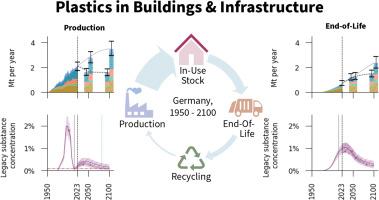德国建筑和基础设施领域的塑料和污染物流动动力学:当前和未来回收的挑战和机遇
IF 10.9
1区 环境科学与生态学
Q1 ENGINEERING, ENVIRONMENTAL
引用次数: 0
摘要
在追求气候中和的同时,满足对塑料日益增长的需求需要回收利用的激增。尽管是德国第二大塑料使用行业,但塑料在建筑和基础设施(B&;I)中的循环潜力仍未得到充分开发。本研究使用高分辨率动态物料流模型(六种产品、八种聚合物、七种遗留物质),调查了1950年至2100年间德国B&;I部门主要产品组的塑料流动、库存和遗留污染。结果显示,塑料库存预计将从2023年的6290万吨增加到2100年的89.5 - 1.631亿吨,具体取决于未来的消费情景。2023年,报废流量比消费量低66%,但预计到2100年将至少翻一番。实现高回收率受到污染物阈值的限制,如各种产品中的DEHP、Pb、HBCD和(H)CFCs。因此,污染物的检测和去除在回收是至关重要的安全和循环塑料的使用。本文章由计算机程序翻译,如有差异,请以英文原文为准。

Plastic and contaminant flow dynamics in the German building and infrastructure sector: Current and future challenges and opportunities for recycling
Satisfying the growing demand for plastics while pursuing climate neutrality requires a surge in recycling. Despite being Germany’s second-largest plastics use sector, the circularity potential of plastics in buildings and infrastructure (B&I) remains largely unexplored. This study investigates plastic flows, stocks, and legacy contamination for major product groups in Germany’s B&I sector from 1950 to 2100, using high-resolution dynamic material flow modeling (six products, eight polymers, seven legacy substances). Results show that plastic stocks are anticipated to increase from 62.9 million metric tons (Mt) in 2023 to 89.5–163.1 Mt in 2100, depending on future consumption scenarios. End-of-life flows were 66 % lower than consumption in 2023 but are projected to at least double by 2100. Achieving high recycling rates is constrained by contaminant thresholds, as demonstrated for DEHP, Pb, HBCD, and (H)CFCs in various products. Consequently, contaminant detection and removal in recycling are crucial for safe and circular plastic use.
求助全文
通过发布文献求助,成功后即可免费获取论文全文。
去求助
来源期刊

Resources Conservation and Recycling
环境科学-工程:环境
CiteScore
22.90
自引率
6.10%
发文量
625
审稿时长
23 days
期刊介绍:
The journal Resources, Conservation & Recycling welcomes contributions from research, which consider sustainable management and conservation of resources. The journal prioritizes understanding the transformation processes crucial for transitioning toward more sustainable production and consumption systems. It highlights technological, economic, institutional, and policy aspects related to specific resource management practices such as conservation, recycling, and resource substitution, as well as broader strategies like improving resource productivity and restructuring production and consumption patterns.
Contributions may address regional, national, or international scales and can range from individual resources or technologies to entire sectors or systems. Authors are encouraged to explore scientific and methodological issues alongside practical, environmental, and economic implications. However, manuscripts focusing solely on laboratory experiments without discussing their broader implications will not be considered for publication in the journal.
 求助内容:
求助内容: 应助结果提醒方式:
应助结果提醒方式:


